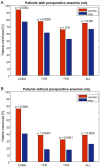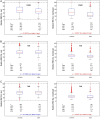Gender disparities in red blood cell transfusion in elective surgery: a post hoc multicentre cohort study
- PMID: 27965248
- PMCID: PMC5168603
- DOI: 10.1136/bmjopen-2016-012210
Gender disparities in red blood cell transfusion in elective surgery: a post hoc multicentre cohort study
Abstract
Objectives: A post hoc gender comparison of transfusion-related modifiable risk factors among patients undergoing elective surgery.
Settings: 23 Austrian centres randomly selected and stratified by region and level of care.
Participants: We consecutively enrolled in total 6530 patients (3465 women and 3065 men); 1491 underwent coronary artery bypass graft (CABG) surgery, 2570 primary unilateral total hip replacement (THR) and 2469 primary unilateral total knee replacement (TKR).
Main outcome measures: Primary outcome measures were the number of allogeneic and autologous red blood cell (RBC) units transfused (postoperative day 5 included) and differences in intraoperative and postoperative transfusion rate between men and women. Secondary outcomes included perioperative blood loss in transfused and non-transfused patients, volume of RBCs transfused, perioperative haemoglobin values and circulating red blood volume on postoperative day 5.
Results: In all surgical groups, the transfusion rate was significantly higher in women than in men (CABG 81 vs 49%, THR 46 vs 24% and TKR 37 vs 23%). In transfused patients, the absolute blood loss was higher among men in all surgical categories while the relative blood loss was higher among women in the CABG group (52.8 vs 47.8%) but comparable in orthopaedic surgery. The relative RBC volume transfused was significantly higher among women in all categories (CABG 40.0 vs 22.3; TKR 25.2 vs 20.2; THR 26.4 vs 20.8%). On postoperative day 5, the relative haemoglobin values and the relative circulating RBC volume were higher in women in all surgical categories.
Conclusions: The higher transfusion rate and volume in women when compared with men in elective surgery can be explained by clinicians applying the same absolute transfusion thresholds irrespective of a patient's gender. This, together with the common use of a liberal transfusion strategy, leads to further overtransfusion in women.
Keywords: Patient blood management; gender; overuse; transfusion.
Published by the BMJ Publishing Group Limited. For permission to use (where not already granted under a licence) please go to http://www.bmj.com/company/products-services/rights-and-licensing/.
Conflict of interest statement
AH lectures for Vifor Pharma and TEM international.
Figures





Similar articles
-
The second Austrian benchmark study for blood use in elective surgery: results and practice change.Transfusion. 2014 Oct;54(10 Pt 2):2646-57. doi: 10.1111/trf.12687. Epub 2014 May 8. Transfusion. 2014. PMID: 24805865
-
Blood use in elective surgery: the Austrian benchmark study.Transfusion. 2007 Aug;47(8):1468-80. doi: 10.1111/j.1537-2995.2007.01286.x. Transfusion. 2007. PMID: 17655591
-
Transfusion thresholds in common elective surgical procedures in Finland.Vox Sang. 2000;78(2):96-100. doi: 10.1159/000031157. Vox Sang. 2000. PMID: 10765144
-
Perioperative anemia: Prevalence, consequences and pathophysiology.Transfus Apher Sci. 2019 Aug;58(4):369-374. doi: 10.1016/j.transci.2019.06.011. Epub 2019 Jul 5. Transfus Apher Sci. 2019. PMID: 31416710 Review.
-
Autologous blood procurement in the surgical setting: lessons learned in the last 10 years.Vox Sang. 1996;71(3):133-41. doi: 10.1046/j.1423-0410.1996.7130133.x. Vox Sang. 1996. PMID: 8912455 Review.
Cited by
-
Treatment of Anaemia in Patients with Acute Burn Injury: A Study of Blood Transfusion Practices.J Clin Med. 2021 Jan 27;10(3):476. doi: 10.3390/jcm10030476. J Clin Med. 2021. PMID: 33514060 Free PMC article.
-
Predictors for Perioperative Blood Transfusion in Patients Undergoing Open Cystectomy and Urinary Diversion and Development of a Nomogram: An Observational Cohort Study.J Clin Med. 2021 Jun 25;10(13):2797. doi: 10.3390/jcm10132797. J Clin Med. 2021. PMID: 34202030 Free PMC article.
-
Impact of gender parity on preoperative anaemia prevalence and Patient Blood Management practice.Blood Transfus. 2021 Sep;19(5):396-402. doi: 10.2450/2020.0158-20. Epub 2020 Sep 17. Blood Transfus. 2021. PMID: 33196412 Free PMC article.
-
Do Patients with Borderline Anemia Need Treatment before Total Hip Arthroplasty? A Propensity Score-Matched Cohort Study.Orthop Surg. 2024 Jan;16(1):123-131. doi: 10.1111/os.13955. Epub 2023 Dec 4. Orthop Surg. 2024. PMID: 38049380 Free PMC article.
-
Lower preoperative hematocrit, longer hospital stay, and neurocognitive decline after cardiac surgery.Surgery. 2020 Jul;168(1):147-154. doi: 10.1016/j.surg.2020.02.001. Epub 2020 Mar 14. Surgery. 2020. PMID: 32178865 Free PMC article.
References
-
- Global Burden of Disease Study 2013 Collaborators. Global, regional, and national incidence, prevalence, and years lived with disability for 301 acute and chronic diseases and injuries in 188 countries, 1990–2013: a systematic analysis for the Global Burden of Disease Study 2013. Lancet 2015;386:743–800. 10.1016/S0140-6736(15)60692-4 - DOI - PMC - PubMed
-
- Blomkalns AL, Chen AY, Hochman JS et al. . Gender disparities in the diagnosis and treatment of non-ST-segment elevation acute coronary syndromes: large-scale observations from the CRUSADE (Can Rapid Risk Stratification of Unstable Angina Patients Suppress Adverse Outcomes With Early Implementation of the American College of Cardiology/American Heart Association Guidelines) National Quality Improvement Initiative. J Am Coll Cardiol 2005;45:832–7. 10.1016/j.jacc.2004.11.055 - DOI - PubMed
Publication types
MeSH terms
Substances
LinkOut - more resources
Full Text Sources
Other Literature Sources
Medical
